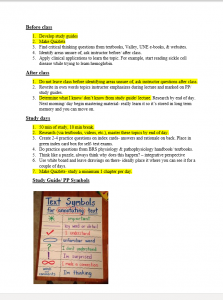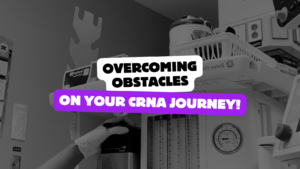Updated: 11/21/2023. This post may contain affiliate links. Please read my disclaimers for more info.
Last week was a continuation of a 4 part blog series on “How to Learn Anything”. In this post, we’ll take a deep dive into the study system I created while in CRNA school.
Read: My CRNA Journey: Surgical Tech To CRNA- The Unbelievable
So let’s break down the steps I took to create my study system that has worked well for me and others as they work towards their goals. You may want to grab a pen or your laptop to type as you go. But first, let’s visit what a study plan actually is.
What is a study plan?
A study plan is an effective way to guide you through your academic studies and promote accountability for your own learning outcomes. It serves as an effective solution for managing time, especially when faced with the challenges of balancing classes, extracurricular activities, work, and family commitments.
By creating a study plan, individuals can gain insights into how they allocate their time, ensuring that they set aside sufficient hours outside of class to complete assignments, study for exams, and reinforce the material.
Your core principles
Remember from the last article, How To Learn Anything: First Identify Your Core Principles, one of the keys to your academic success is all about defining the principles you live by. This will allow you to hit the ground running with a growth mindset. This will also lead to you having a clear vision as a student and future CRNA. And last, what I love is all this will drive your commitment, actions, and confidence.
Determine your learning style
Trying to understand how I learned best was a challenging assignment, to say the least. However, figuring out your learning style is needed in order to create your study system.
There are a number of different learning styles. In 1992, Fleming and Mills, both educators described the four common learning systems known today by the acronym VARK: visual, auditory, reading/writing, and/or kinesthetic. Here is the VARK questionnaire to help you determine which one you are.
- If you are a visual learner, then you would understand the different learning styles by looking at this picture.
- Being an auditory learner, you pick up things best by hearing and listening. Therefore, listening to a podcast or watching a YouTube video on mechanical ventilation may be more helpful than reading about it. Also listening to music may help you focus while studying.
- If you are a reading/ writing type of learner, then reading your assignments and writing papers will come naturally to you. This type of learner should print out their material instead of just reading it on their laptop.
- And being a kinesthetic learner just means you need to touch things physically with your hands like in a lab or simulation. You are the type of person that must do it to understand it. The feelings associated with this learning style play a huge part in you learning the material. If you are this type of learner, you need to write out the words, make posters, or utilize your whiteboard.
Either way, there is no right or wrong way to learn. And you may be a mixture of any of these learning styles. For instance, my learning style is mostly visual but also kinesthetic. See if you can tell this by my study system below. So, figuring out how you learn will determine how successful you will be after implementing your very own study system.
Read: Tips For Surviving CRNA School
And finally, MY STUDY SYSTEM
So, here is how I prepared and hopefully, it helps you create your own unique study system. Get started on it now so you don’t have to experience the stress and panic I went through while in CRNA school.
First, I divided my study system into sections: Before lecture, during lecture, after lecture, study days, etc.
Before lecture
- I made study guides from the PowerPoints that were posted ahead of time. The key is to make sure you re-word the content in the study guide so it makes sense to you.
- I then proceeded to make Quizlets for each chapter. The website, Quizlet, is a great site with a lot of study material from different courses already available. You just need to enter the title of the course or chapter in the search bar. Feel free to check out ALL the questions I made on Quizlet under the username kj2kind. I hope you find them useful.
- I then studied using the study guides I created and took it a step further by identifying areas I still was unsure of. I made sure to write it out on the outer margins of the study guide. Highlight or write out this information in another color to remind yourself to ask the instructor about these concepts after the lecture if you still don’t understand them. This is so important!!! Don’t skip this step.
- I also looked for ways to apply clinical applications in order to learn the topic. For example, you would read up on COPD while studying CO2 or oxygenation.
During lecture
- Your only job during the lecture is to try to comprehend what the instructor is teaching. At this point, You should be familiar with the material since you made a study guide prior to the lecture. Also, pay close attention to the instructor’s change in voice or if they keep repeating the same thing over and over. Usually, this means you will see this information again later. This should also be written down or highlighted in the study guide.
At this point you are probably starting to see a pattern. The study guide is the be-all and end-all. So guard it like your life depends on it.
After lecture
- After doing all the work above, it is imperative you do not leave class before identifying areas unsure of. You must ask the instructor for help before leaving the classroom!!! No questions asked. And if they say you need to make an appointment, then be sure to email them before you leave the classroom.
- You’ve received clarification on topics not quite understood and have concepts the instructor has emphasized written down. Now rewrite these topics into your own words as well. I like to put this somewhere on the study guide so everything is in one place.
- This is a biggie- Determine what you do know or still have no clue from the study guide/ lecture. Research those topics or concepts before the end of the day. The next morning or day you must begin mastering the material so it’s stored in long-term memory before moving on.
Here is a breakdown of my study days:
- 50 min of study, 10 min break. In my first couple of semesters, I studied all day without taking breaks, eating, or drinking water. My brain was fried and I wasn’t retaining anything so all that time spent studying was a waste. Research shows that taking purposeful breaks from studying not only refreshes your brain but also increases your energy, productivity, and ability to focus.
- Research via textbooks, and videos, and master these topics by the end of the day.
- Create 2- 4 practice questions on index cards- answers/ rationales on the back. Then place them in an index card box for self-test exams. I started doing this but eventually started adding these questions to my Quizlets.

- Do practice questions from BRS Physiology and a Pathophysiology handbook/ textbook. I recommend you guys get the BRS physiology handbook. OMG! It is so easy to read and comprehend. Here is a link here. However, I never really found a great pathophysiology book. Do you know of one? Let me know in the comments if you know of one.
- Think like a puzzle, always think why does this happen? Integrative perspective. Basically, this is an approach where the learner uses their prior knowledge to support new theories and experiences. This allows you to go one step further to a more complex level. If you can get this down, you are golden. You’ve hit the jackpot.
- Use a whiteboard and leave drawings on there- ideally, place it where you have no choice but to see it for a couple of days. This will allow you to recall the information and store it in your long-term memory.
- After making my question bank using Quizlet I would then study them for a minimum of 1 chapter per day at least.
The next steps
So there you have it. The study system I created has allowed me to learn anything when I absolutely thought I couldn’t. It took months for me to do all the research needed to get this one page. A page I would laminate and carry with me everywhere. I have shared it with many students who’ve all had success using it. So I hope it does the same for you.
The next post will be the final post in this 4 part series. We’ll end it with how to further ensure your study system works for you. In this post, I will give you the secret to creating a foolproof study system along with a ton of tips. Don’t worry we are going to get you to where you need to be in order to learn anything!
P.S. Check out the first post and second posts!







